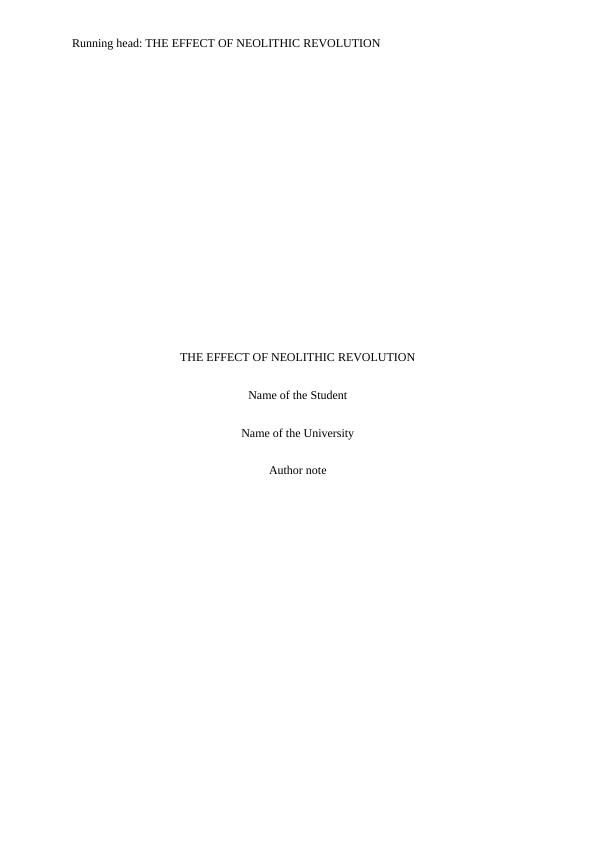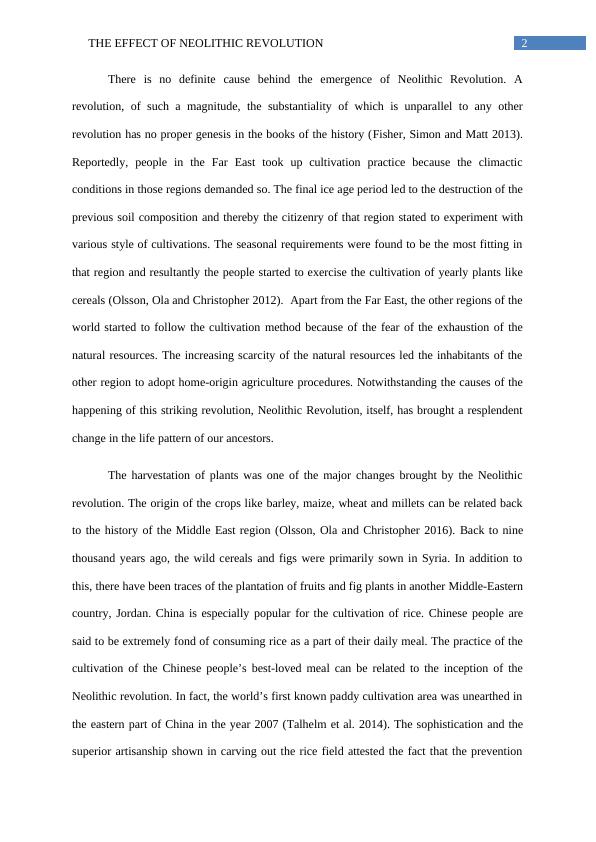Ask a question from expert
The Effect of the Neolithic Revolution Assignment
7 Pages1821 Words401 Views
Added on 2020-04-13
The Effect of the Neolithic Revolution Assignment
Added on 2020-04-13
BookmarkShareRelated Documents
Running head: THE EFFECT OF NEOLITHIC REVOLUTIONTHE EFFECT OF NEOLITHIC REVOLUTIONName of the StudentName of the UniversityAuthor note

1THE EFFECT OF NEOLITHIC REVOLUTIONNeolithic Revolution is regarded to be a miraculous transition in human society. Thisparticular revolution led to the pervasive transformation of human society from a custom ofbarbarous hunt and collection to one of cultivation and civilization. The formation of thesescattered communities instigated humans to inculcate the interest to monitor and probe thelifecycle of plants (Gellner 2017). The above cognizance gradually piloted the art ofcultivation of flora. It can be said that the advent of the Neolithic Revolution led to theemergence of some illustrious developments in human antiquity such as the origination of thewheel, the sowing of the grain produce and the evolution of round hand script, arithmetic,selenology and agronomy. This research essay paper demonstrates the fact that NeolithicRevolution had brought a change in the life of our ancestors. Neolithic Revolution has indeed bought a significant change in the life of all ourancestors. The phenomenon of Neolithic Revolution had originated in the pre-historic times;somewhere back twelve thousand years ago. Like the animals, previously, humans wereaccustomed to the hunter-gatherer conventional more. Humans were extremely proficient insustaining themselves through a ferocious means of livelihood. The concept of socialcivilization, which at present we abide to, posthumously, was an alien belief at that time(Gellner 2017). The prevalent notion of survival at that time can be better expressed throughthis phrase-The survival of the fittest. Sometime at that prehistoric period, Neolithicrevolution developed, bringing a drastic change in the livelihood practices of the Homosapiens. The main change, which was brought by the occurrence of Neolithic Revolution, wasthe inception of agriculture. The development in agriculture propelled the construction ofurban settlements and communities. The human population also ballooned from six million tomore than eight billion (Shiva 2016). This drastic change in the population can be attributedto the suitability of the environment and the availability of resources to practice cultivation ofcrops and animal husbandry.

2THE EFFECT OF NEOLITHIC REVOLUTIONThere is no definite cause behind the emergence of Neolithic Revolution. Arevolution, of such a magnitude, the substantiality of which is unparallel to any otherrevolution has no proper genesis in the books of the history (Fisher, Simon and Matt 2013).Reportedly, people in the Far East took up cultivation practice because the climacticconditions in those regions demanded so. The final ice age period led to the destruction of theprevious soil composition and thereby the citizenry of that region stated to experiment withvarious style of cultivations. The seasonal requirements were found to be the most fitting inthat region and resultantly the people started to exercise the cultivation of yearly plants likecereals (Olsson, Ola and Christopher 2012). Apart from the Far East, the other regions of theworld started to follow the cultivation method because of the fear of the exhaustion of thenatural resources. The increasing scarcity of the natural resources led the inhabitants of theother region to adopt home-origin agriculture procedures. Notwithstanding the causes of thehappening of this striking revolution, Neolithic Revolution, itself, has brought a resplendentchange in the life pattern of our ancestors. The harvestation of plants was one of the major changes brought by the Neolithicrevolution. The origin of the crops like barley, maize, wheat and millets can be related backto the history of the Middle East region (Olsson, Ola and Christopher 2016). Back to ninethousand years ago, the wild cereals and figs were primarily sown in Syria. In addition tothis, there have been traces of the plantation of fruits and fig plants in another Middle-Easterncountry, Jordan. China is especially popular for the cultivation of rice. Chinese people aresaid to be extremely fond of consuming rice as a part of their daily meal. The practice of thecultivation of the Chinese people’s best-loved meal can be related to the inception of theNeolithic revolution. In fact, the world’s first known paddy cultivation area was unearthed inthe eastern part of China in the year 2007 (Talhelm et al. 2014). The sophistication and thesuperior artisanship shown in carving out the rice field attested the fact that the prevention

End of preview
Want to access all the pages? Upload your documents or become a member.
Related Documents
Consequences of Domestication in the Neolithic Age Research Paper 2022lg...
|4
|861
|10
Origin of plants and animal domestication, cost and benefits of agricultural production in relation to ingredients of beef pilaulg...
|6
|1448
|216
Comparing Food Production from Tilling and Pastoralism in European Regionslg...
|7
|1577
|165
Evolution of Human: From Australopithecus to Homo Sapienslg...
|12
|2550
|127
Human Evolution Assignment PDFlg...
|12
|2512
|122